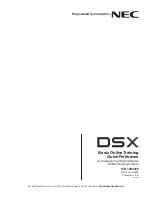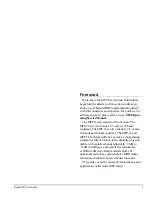
Q: Can this transmitter / receiver be used to transmit surround sound to rear speakers ?
A:
Yes. In this case the transmitter needs to be connected to the two rear speaker channels of your
surround-sound decoder. Some surround-sound decoders do not offer RCA line audio outputs for
the rear speakers. In this case, we recommend the Model 1520 and 1550 transmitter / amplifiers.
Please note that the receiver cannot be directly connected to passive speakers.
Q: What are the benefits of transmitting the full data rate without using audio compression ?
A:
Since our transmitter transmits a data rate of over 3 Mbps (3 million bits per second), the audio
can be transmitted without audio compression. Also, forward error correction can be used. The
reason that other systems use audio compression is to reduce the extremely high data rate of a
pure (uncompressed) audio signal in order to either be able to store that signal or transmit that
signal more easily.
The biggest drawback of using audio compression is that the quality of the audio signal is reduced,
such as in MP3-compressed audio. This is because audio compression removes parts of the music.
Some types of music which are particularly difficult to compress without noticing audio degradation.
Systems using audio compression are not able to deliver CD-quality audio.
Q: Will my 2.4 GHz cordless telephone or wireless LAN affect the operation of the transmitter
/ receiver or vice versa ?
A:
While the transmitter will normally not affect the operation of a 2.4 GHz cordless telephone or
wireless LAN, the receiver may mute while the telephone or wireless LAN is being operated. The
range of the transmitter may also be affected during the operation of other 2.4 GHz equipment. If
you do operate a 2.4 GHz cordless telephone or wireless network close to the receiver, we
recommend that you purchase one of our 5.8 GHz models to eliminate any possibility of
interference. Whether or not the receiver will be affected by other 2.4 GHz devices depends to a
large degree on the type of equipment and the distance between such equipment and the receiver
relative to the audio transmitter. Digital cordless telephones are more likely to cause problems than
analog cordless telephones. The base station of certain types of cordless telephones, such as the
Siemens Gigaset or Panasonic Gigarange series, will periodically broadcast signal beacons, even
when the telephone is not in use, that may cause a clicking noise of the receiver. Walls located
between such equipment and the receiver will in many cases attenuate an interfering signal enough
for it not to cause any problems when operating the receiver. The receiver itself employs an error
correction scheme and thus can tolerate interference up to a certain degree without any signal
degradation. If interference is a problem and if there is no direct line-of-sight to the audio transmitter
then the use of RangeBooster modules is recommended.
Contacting Amphony S upport
For contact details and Local Sales Representatives, visit the Amphony web site at:
http://www.amphony.com
Amphony has made best efforts to ensure that the information contained in this document is accurate and reliable. However, t he
information is subject to change without notice and is provided “AS IS” without warranty of any kind (express or implied). No
responsibility is assumed by Amphony for the use of this information, nor for infringements of patents or other rights of third
parties. This document is the property of Amphony and implies no license under patents, copyrights, trademarks, or trade
secrets. No part of this publication may be used as a basis for manufacture or sale of any items without the prior written consent
of Amphony. The names of products of Amphony or other vendors and suppliers appearing in this document may be trademarks
or service marks of their respective owners which may be registered in some jurisdictions. A list of Amphony trademarks and
service marks can be found at http://www.amphony.com.
© 2004 Amphony 3





















